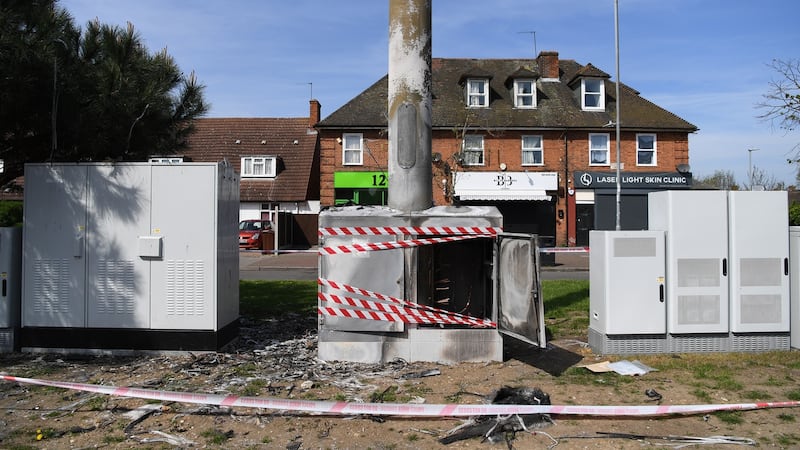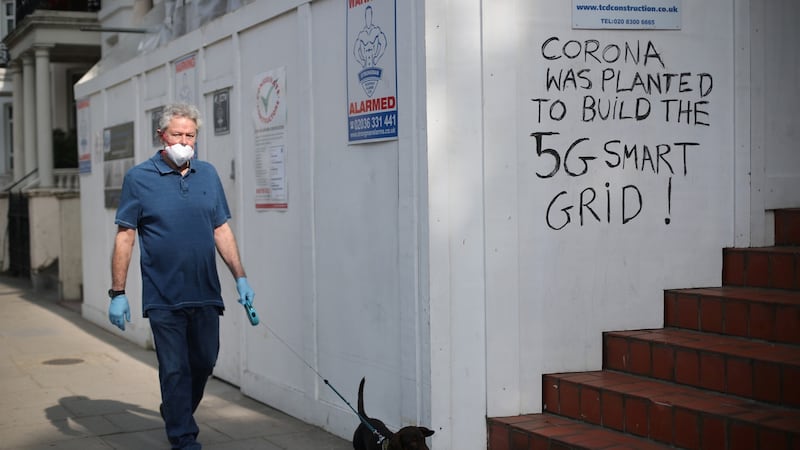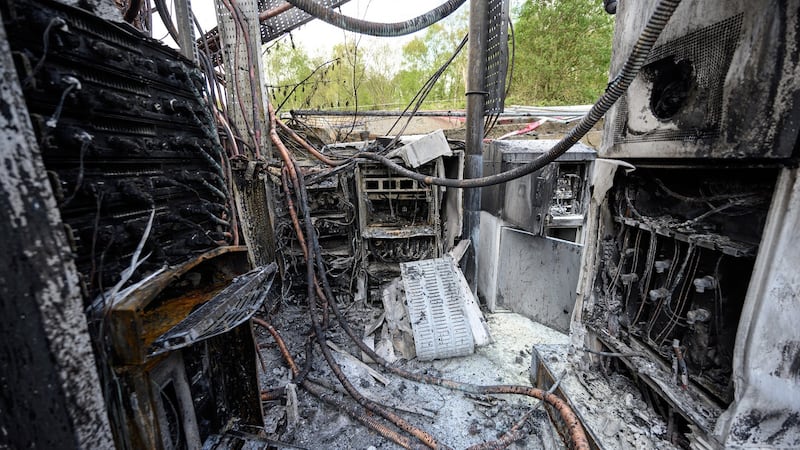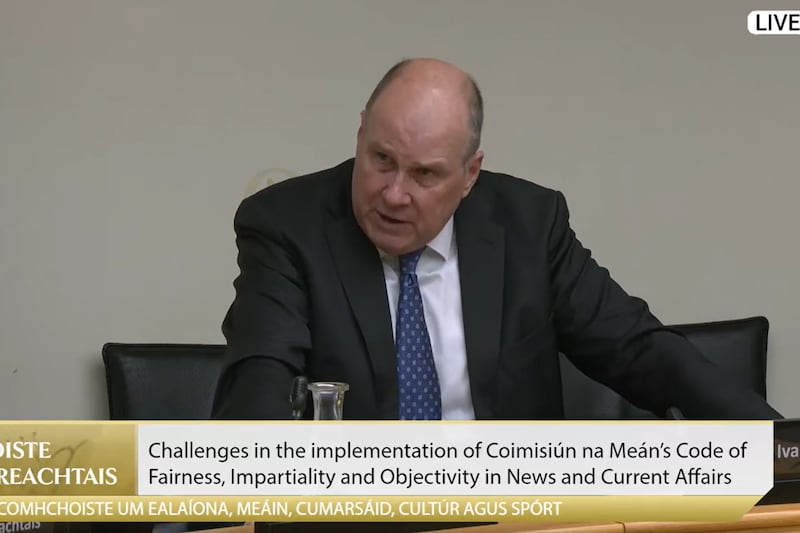There is a relatively new global ranking, where the UK is a world leader and Ireland comes in at number three. Unfortunately it's the number of arson attacks on 5G telecoms towers in recent months. According to Belgian industry association Agoria almost 70 per cent of reported incidents across Europe can be attributed to the UK with a further 23 per cent in the Netherlands and roughly 3 per cent here in Ireland.
Driving these acts of vandalism are the various conspiracy theories linking 5G technology to the coronavirus. The claims begin with a conviction that 5G radio waves are dangerous to our health: 5G weakens the immune system and this is why Covid-19 has been so devastating. Then we get into more shady territory: some believe 5G radio waves actually cause Covid-19.
The most extreme claim is that governments and powerful entities around the world orchestrated the Covid-19 pandemic: it was introduced as a man-made virus to distract from the installation of 5G towers around the world, or, depending on what flavour of conspiracy you prefer, Bill Gates created the coronavirus and is spreading it via 5G so that he can make money on a vaccine.
Leaving aside for now the multitude of bizarre and implausible claims contained within these conspiracy theories, one wonders how it spread from online fringe groups to real-life arson attacks. Social media appears to have played a significant role.
Social media researcher Dr Wasim Ahmed recently led a study on Twitter activity around the #5Gcoronavirus hashtag and found that despite the volume of tweets, only 35 per cent expressed views explicitly linking Covid-19 to 5G technology. Interestingly, 32 per cent of tweets using this hashtag were actually denouncing the conspiracy theory but it may be counterproductive.
“As soon as #5Gcoronavirus became popular on social media, a lot of people started to join in, using the hashtag to ridicule, retweet and share these conspiracy theories. But this had the effect of extending the reach of the overall topic,” explains Ahmed.
“Twitter users with a large number of followers were quoting these tweets and exposing them to even more people. If we removed those 32 per cent of tweets that were criticising or ridiculing the 5G conspiracy theories, maybe the topic would not have been trending the way it was.”
A better way to fight this kind of disinformation would be to report these tweets rather than giving them a platform and the exposure they desire, advises Ahmed.
“Twitter itself has been careful about this. They have left some 5G/coronavirus content on the platform because of freedom of speech, but they have been removing anything inciting violence or encouraging people to damage 5G masts. Maybe they could have been a bit faster to remove that content and possibly have a more streamlined ability for users to report certain tweets,” he adds.
Although 5G may be an emerging technology, conspiracy theories are nothing new. There has always been an appetite to believe that powerful entities are covering up something or other. A 2013 poll from US survey company Public Policy Polling came up with some interesting numbers: 12 million Americans believe lizard people run the country, almost 22 million are convinced the moon landing was faked, 47 million believe the medical industry purposely manufactures diseases, and 116 million believe global warming is a hoax.

"There are two competing theories on why people buy into conspiracies," explains Dr Ciara Greene, associate professor in the School of Psychology at University College Dublin. "One is the idea of motivated reasoning: people tend to fall for something that confirms what they already believe. If you are the kind of person who doesn't trust the government you will be drawn to stories that echo this.
“This holds true for political leaning. If you read about a scandal within a political party you dislike you are more likely to believe this than a similar story about the party you do support.”
There is also new research on the psychology of conspiracy theories, which suggests that motivated reasoning doesn’t fully explain why people believe the things they do. This research looks at the correlation between engaging in critical thinking or analytical reasoning and disregarding conspiracy theories.
According to Dr Greene: "People who are more likely to think things through are less likely to accept misinformation at face value. They are more likely to stop and think: 'Wait, what is the source and is it reliable, does this fit with what I already know'.
“It is linked to intelligence but it is more about a cognitive style. There is a lot of research around hot and cold thinking; whether someone reacts immediately to something or slows down to consider the information they have been given.”
Why 5G?
Falling for the notion that 5G is somehow causing or exacerbating the spread of Covid-19 is therefore, in part, down to a failure to stop and assess whether something is true just because it feels true. But why 5G in particular? Why didn’t we see this kind of fear of and opposition to 4G or other technological innovations?
Resistance to 5G and fears of side effects are nothing new. This has always happened with the advent of new technologies. It might be far into the rear view but when mobile phones were introduced in the early 1980s there were concerns that they could cause cancer and early models came with warning labels. It persisted into the noughties: in 2001 media across Europe were still debating the safety of mobile phones and advising minors to hold these devices away from their head when dialling or texting.

"I've been involved in this issue for about 30 years; I first got involved in the transition from 1G to 2G. We've seen similar claims all the way along,' says Dr Jack Crowley, from the Advocacy Department of the GSMA (Global System for Mobile Communications).
Speaking at last week's COMPACT digital symposium, a European Commission initiative aimed at addressing public queries and concerns around 5G technology, Crowley said he can remember concern groups saying 3G deployment was unsafe while simultaneously feeling 2G was fine.
“There are many features of the technology that people don’t understand. The fact that radio waves are invisible and their strength can’t be seen or heard makes it mysterious and therefore prey to sensational claims.”
The only difference this time around, says Crowley, is that social media has played a significant role in the amplification of such fears: “In the past it was a local or national issue and now it’s an international one.”
In his 2016 book Innovation and its Enemies: Why People Resist New Technologies, the late Calestous Juma, then Faculty Chair of the Innovation for Economic Development Executive Program at Harvard Kennedy School, argued that technological controversies are born of tensions between the need to innovate and the pressure to maintain a society's continuity and stability. And these tensions are compounded by how fast technology moves.
“Many of these debates over new technologies are framed in the context of risks to moral values, human health, and environmental safety. But behind these genuine concerns often lie deeper, but unacknowledged, socioeconomic considerations,” wrote Juma.
And perhaps a key part to understanding why 5G towers are being attacked Luddite-style in 2020 is economic fallout being triggered by the Covid-19 pandemic. Juma noted: “Technological tensions are often heightened by perceptions that the benefits of innovation will accrue only to small sections of society, while the risks will be more widely distributed.”
This, ultimately, is the basis of most conspiracy theories: the rich and powerful are in control and the rest of us are being hoodwinked.
"There have been genuine, serious cover-ups in the past, which helps lend a sense of credibility to these spurious claims," points out Paul O'Donoghue, adjunct assistant professor in the school of psychology, University College Dublin, and a founder member of the Irish Skeptics Society.
“For example the tobacco industry [covering up the link between smoking and lung cancer], big pharma – this is in reference to profiteering off the back of dubious clinical trials and not a conspiracy to create diseases – and car manufacturers [and the diesel emissions scandal]. If they have done it, why can’t many others?
“But I think the reason the 5G connection has taken root in particular may be because publicity concerning this pretty much coincided with the pandemic outbreak. Correlation is often confounded with causation,” he explains.
Some individuals have made a link between the arrival of Covid-19 and the installation of 5G towers. In particular, they connect the fact that the virus originated in Wuhan to the installation of 5G masts in that city.
“Needless to say, no fact checking has been carried out by these conspiracy theorists around Covid-19 outbreaks in countries where no 5G masts have been installed,” adds O’Donoghue.
This makes it difficult – and frustrating – for scientists to explain why 5G is a safe technology. Added to this is the pseudoscientific language often used by conspiracy theorists.
“Many surveys have shown that the general level of scientific literacy across many countries is very low. The ‘scientific’ sounding words from conspiracy theorists lend credibility to nonsense,” he explains.

“One member of the public, for example, was pointing out that it has been demonstrated that 5G lines deplete oxygen in the atmosphere. This may sound plausible, especially when it is claimed that it has been demonstrated by scientists. So [belief in conspiracy theories] may in fact reflect naive trust in science rather than distrust.”
In addition to the vandalism or destruction of private property, these 5G conspiracy theories could also be damaging to innovation, perhaps causing enough public alarm to stunt roll-out of fast and energy-efficient connectivity that many businesses and individuals would benefit from.
"We know that unfortunately it can be destructive for policy. We have heard policymakers around Europe voicing concerns related to this disinformation around 5G. It might even delay the deployment of 5G," said Dr Lukasz Porwol, speaking at the COMPACT symposium.
Media literacy
So how do we go about bolstering critical faculties to avoid being taken in by scientific-sounding garbage that has the potential to cripple widescale technological innovations? Digital and media literacy can play an important role in fighting scientific disinformation says Dr Greene.
"My colleague Gillian Murphy and I are looking at the interventions that can be developed to enhance people's critical-reasoning skills. There are some free online courses out there on digital literacy, the only problem is that they are self-selecting in that the people who tend to choose to take them often aren't the people who need it.
“With the proper evidence base, I would like to see digital literacy skills integrated into school curricula so that everyone gets access to it,” she adds.
What can also help in fighting the spread of these kinds of conspiracy theories is government intervention. “One thing that emerged from our data is we didn’t see an influential account from government or any high-profile influencer come out and say: ‘We know this hashtag is trending but it is completely false’,” says Ahmed. His paper made the recommendation that policymakers should insist on government efforts to counter fake news with this kind of intervention.
Crowley echoes this sentiment: “There has been a lack of voices in terms of organisations such as the WHO whose focus on social media was around the primary health issues related to Covid-19. They missed what we saw – that this disinformation around 5G and Covid-19 was bubbling up early on.”
There are lessons to be learned from all of this. Not all people can be convinced with facts and evidence-based reasoning but we can all benefit from learning to critically evaluate online information and perhaps the most important advice of all: your hashtagged outrage at #5gcoronavirus #covidiots is fodder, so don’t feed the trolls.
















